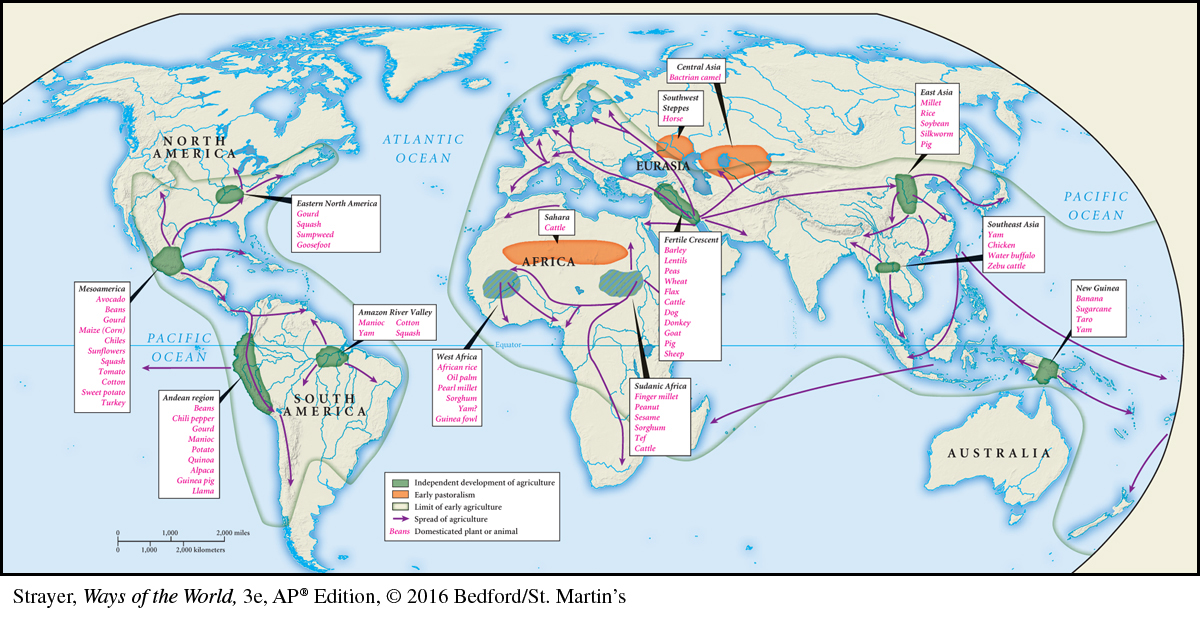Common Patterns
AP® EXAM TIP
Take good notes on how the Neolithic Revolution developed around the world and the similarities and differences of these developments.
Perhaps the most extraordinary feature of the Neolithic or Agricultural Revolution was that it occurred, separately and independently, in many widely scattered parts of the world: the Fertile Crescent of Southwest Asia, several places in sub-

Guided Reading Question
▪CHANGE
What accounts for the emergence of agriculture after countless millennia of human life without it?
It is no accident that the Agricultural Revolution coincided with the end of the last Ice Age, a process of global warming that began some 16,000 years ago. By about 11,000 years ago, the Ice Age was over, and climatic conditions similar to those of our own time generally prevailed. This was but the latest of some twenty-
AP® EXAM TIP
You should know the features and contributions of gathering and hunting peoples.
Over their long history, gathering and hunting peoples had already developed a deep knowledge of the natural world and, in some cases, the ability to manage it actively. They had learned to make use of a large number of plants and to hunt and eat both small and large animals, creating what archeologists call a “broad-spectrum diet.” In the Middle East, people had developed sickles for cutting newly available wild grain, baskets to carry it, mortars and pestles to remove the husk, and storage pits to preserve it. Peoples of the Amazon and elsewhere had learned to cut back some plants to encourage the growth of their favorites. Native Australians had built elaborate traps in which they could capture, store, and harvest large numbers of eels.
In hindsight, much of this looks like a kind of preparation for agriculture. Because women in particular had long been intimately associated with collecting wild plants, they were the likely innovators who led the way to deliberate farming, with men perhaps taking the lead in domesticating animals. Clearly the knowledge and technology necessary for agriculture were part of a longer process involving more intense human exploitation of the earth. Nowhere was agriculture an overnight invention.
Using such technologies, and benefiting from the global warming at the end of the last Ice Age, gathering and hunting peoples in various resource-rich areas were able to settle down and establish more permanent villages, abandoning their nomadic ways and more intensively exploiting the local area. In settling down, however, they found themselves now required to support growing populations. Evidence for increasing human numbers around the world during this period of global warming has persuaded some scholars that agriculture was a response to the need for additional food, perhaps even a “food crisis.” Such conditions surely motivated people to experiment and to innovate in an effort to increase the food supply. Clearly, many of the breakthroughs to agriculture occurred only after gathering and hunting peoples had already grown substantially in numbers and had established a sedentary way of life.
These were some of the common patterns that facilitated the Agricultural Revolution. New opportunities appeared with the changed climatic conditions at the end of the Ice Age. New knowledge and technology emerged as human communities explored and exploited that changed environment. The disappearance of many large mammals, growing populations, newly settled ways of life, and fluctuations in the process of global warming — all of these represented pressures or incentives to increase food production and thus to minimize the risks of life in a new era. From some combination of these opportunities and incentives emerged the profoundly transforming process of the Agricultural Revolution.